
I grew up playing all kind of sports. My hometown is
known for having great football. As kids,
we grew up wanting to play for the varsity squad. When I was in fifth grade, I was lucky enough to be the water boy for the varsity team. Two years
later, I was promoted to ball boy. I was ball boy until I played quarterback
on the team. My senior year, we won the state championship and I was the AA
Player of the Year in South Carolina.
After high school, I played football in college and we won
the Big South Championship. Two weeks after graduating college, I found myself
in Europe playing football. We won the
national
championship
in Finland and our team was invited to the EuroBowl the
following year. I played two seasons in Europe, then returned back home and helped
coach my high school team. After losing the state championship two years in a
row, we finally
won the championship in 2010.
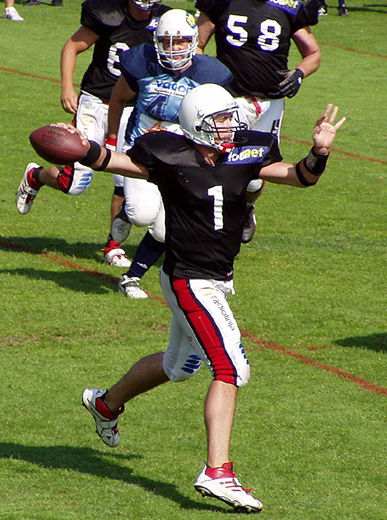
Pictured: That's me. Quarterbacks need good balance, vision and poise.
Throughout the many seasons and teams I’ve played on I’ve
been fortunate to have been a part of
several championship teams. I’ve seen programs from the perspective of the smallest
spoke in the tire as waterboy, to the central spoke of the offense as quarterback, as well as from the perspective of coach. From these various
perspectives, I’ve
learned a lot about teamwork, both effective and ineffective
leaders, and the position of quarterback.
Community Managers are Quarterbacks
of Their Communities
Now that my quarterbacking days are over, I find myself applying several principles I learned on the field. I guess
its human nature to draw from our past experiences. My day job is Sales Engineering Manager at
DNN. Outside of work, I manage an online community for outdoor enthusiasts. Check out my related blog series on creating sustained engagement in communities.
Side note: the outdoor enthusiast community is powered by DNN's
online community solution, Evoq Social.
I find
a lot of parallels between being a quarterback on the field
and being a community manager online. In this blog series, I’d like to highlight how community managers are the quarterbacks of their communities and illustrate why they are critical to their communities' success.
Reasons Community Managers Are Quarterbacks of their Community
Leadership
One of the first things you learn about being a quarterback
is the importance of leadership. When you’re in the huddle, all eyes are
looking to you for direction. When the team is down and needs a pep talk, you’re
the guy to give it. When things get tough, you need to step up and make a play.
When reporters want a post-game interview, they always look for the quarterback to make
comments about the team.

Pictured: After the game, most reporters seek out the team's quarterback.
In the same manner, the community manager sets the tone for
the community. When
new features are needed, the community manager must find
ways to make it happen. When new members join the community, it’s always
helpful for the community manager to welcome them on board and
help them get
acquainted
to the community. The community manager leads the community by
deciding which content to approve and reject for the site. The community manager’s interactions and relationships with members
set the
direction of the overall community.
Quarterbacks have different leadership styles.
I am a fan and advocate of the
Servant Leadership philosophy. This
style of leadership turns the leadership pyramid on its head and puts the
leader at the bottom,
serving all those who report to them. As a quarterback,
you serve your team, your school, your teammates, and in some cases, even
your town. Likewise, community managers serve their members and
their organization. Just as a quarterback’s
play directly affects the outcome of the game, a community manager’s
performance plays a
significant role in the success of a community.
 "A Community Manager’s role as a leader of the community is critical to the community’s success."
"A Community Manager’s role as a leader of the community is critical to the community’s success."
Time Management
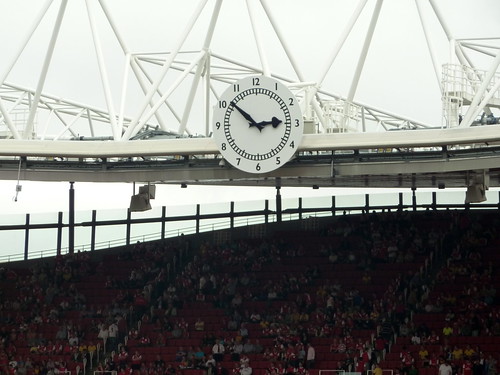
Photo source: User wonker on
flickr.
You have to have physical skills and talents to play
quarterback, but you quickly learn that your talents mean nothing if you don’t
know how to manage time. As a quarterback, you have to be constantly aware of
the clock: not just the game clock, but also the play clock. You
need to know
how much time you have left in the game, as well as how much time is left before
you have to get the next play off. Ultimately, the quarterback must execute the plays of each drive as they relate to the timeline of the larger
game.
RELATED: Read Part 2 and Part 3 on this blog series on community management.
As a community manager, time management is also important.
Community managers need to be informed of seasonal trends and events, along with any timely
things going on around their community. Fan-based communities, sports-oriented
communities, and any community with annual traditions or events are communities
in which the
community manager must be time-aware.
These annual events may justify changes in site design, the creation of new banners, the launch of competitions, or increased messaging
in your communities. Just as each play of a game is important to a quarterback,
the moments and interactions on community sites are important to the community
managers. When you
add them all together, they make up the game, season,
or year in your community.
 "Be aware of your community’s traditions, rituals, seasonal activities and annual events."
"Be aware of your community’s traditions, rituals, seasonal activities and annual events."
Strategy

Photo source: User John-Morgan on
flickr.
A close tie-in to
time management is having a strategy. As a football team, you have season-long
strategies; each week, you have specific game-by-game strategies. On
some of my teams, we implemented quarter-by-quarter strategies to
keep opposing
teams on their toes.
It's important to have a strategy for each segment of your journey as a community
manager. Maybe in the first year, you
focus on onboarding new members. You might transition to focusing on member engagement in year
two. Whether your strategy is by year or by month, you need
direction to guide your decisions, interactions, and
actions as a community manager. Without a strategy, there is no end
goal, no measurable conversion rate, no attainable objectives, no
benchmarks to look back upon or compare by, and no marching orders for the
community manager to go by.
 "Alongside strategy, build in some goals to measure the success of your community."
"Alongside strategy, build in some goals to measure the success of your community."
Know
Your Personnel
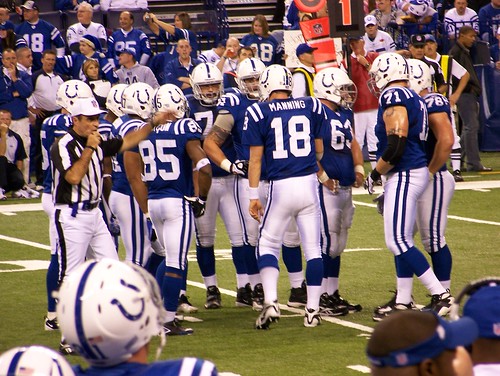
Photo source: User spablab on
flickr.
You can be as good as Peyton Manning, but if your teammates don’t want to
play with you, then your talents are rendered worthless. If the
team
doesn’t gel in a team sport, you won't be successful.
To be a successful quarterback, you
need to know your
teammates. You need to find out what’s important to them, what makes them tick,
what motivates them. In order to do this, you must spend time with them. You can
practice together, lift weights together, study film together, go out to eat, just really anything.
They need to know that you care about them on a
personal level. Once you get on the field, you need to know your teammates'
strengths and weaknesses on an athletic level. If things are going right, they’ll know your's, too.
A community manager can benefit from the very same
principles. Your members are
much more likely to interact and participate if they know you’re listening and
engaged with them. Yes, in very large communities it may be difficult to get
to know every single community member, but the
larger the community, the more community
managers you can have. Community members who feel closely linked to the community manager feel a tight bond to the community. Relationships help people, whether
teammates or community members, feel more welcome and comfortable.
 "The more you get to know your community members, the more they will engage with you."
"The more you get to know your community members, the more they will engage with you."
What's Your Community Management Quarterbacking Style?
Click one of the selections below to share (tweet) the quarterback who best represents your community management style.

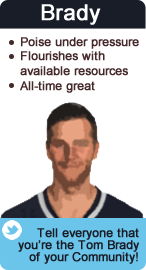
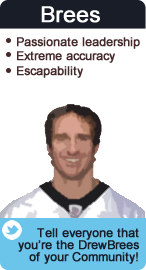

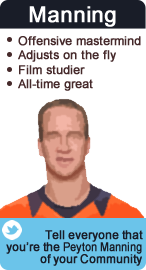
What's Next
This is part one in a multi-part blog series. Read
part 2 and part 3 of the blog series now.